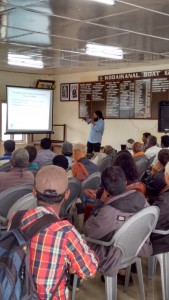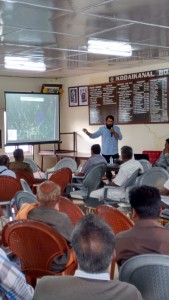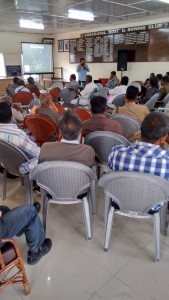The Human –wildlife conflict stakeholder workshop held at Kodaikanal, was very well attended, with over 90 registered participants. There was an introduction to the workshop given by Madhu Ramnath (Palni Hills Conservation Council), which was followed by Samraj (Keystone Foundation) who introduced Keystone Foundation as well as provided the aims and objectives of the workshop.
 The introductory session was followed by a presentation by Abhishek on different perspectives that could be considered when understanding conflict, as well as some of the contributing factors which might lead to an escalation of conflict. The need for greater collaboration and communication between the various stakeholders involved, as well increase awareness of the contributing factors among them.
The introductory session was followed by a presentation by Abhishek on different perspectives that could be considered when understanding conflict, as well as some of the contributing factors which might lead to an escalation of conflict. The need for greater collaboration and communication between the various stakeholders involved, as well increase awareness of the contributing factors among them.
A keynote address was delivered after the presentation by District Forest Officer (kodaikanal) Mr Venkatesh on the scenario in Kodaikanal, and his perspectives and experiences of having been stationed in Kodaikanal. He highlighted that compensation mechanisms were functioning efficiently when legitimate claims for compensation were filed, and also that most victims of crop damage did not have the required documents needed to file and claim for compensation due to wildlife related losses.
Following a quick break for tea, Samraj highlighted the main themes of the discussion along which the workshop was aligned, mainly:
i) What are the possible solutions for occurring conflict situations
ii) What are the possible ways in which these situations could be managed
iii) Opinions on the current scenario from farmers, planters and the officials from the forest department.
Some of the main opinions and concerns presented during the discussion session were the need for a subsidy for building electric fences (or other physical mitigation barriers) for protecting agricultural fields, lack of communication and clarity from the forest department regarding compensation mechanisms.
The lack of open and frank communication between the Forest Department and the farmers was also highlighted as part of the discussion, and in response, the Forest Department was also keen on collaborating with other governmental agencies in the region, responsible for different aspects of governance. Waste Management and pollution of Natural Resources was a major concern which was highlighted many times over.
There was also considerable discussion on the effects of having Acacia and Eucalyptus plantations around the region, and the long-term impacts of having these plantation species around, especially around agriculture lands. The DFO responded to these complaints by highlighting that these plantations were established a long time ago and the dying of the grasslands had a lot to do with inconsiderate use and encroachment of wetland areas. He also added that eradication of the ‘invasive plants’ would require an efficient and proven strategy as the regeneration rate of most of these species was very high, and controlling unchecked growth could potentially become a bigger problem.
There were also interesting opinions about tourism and how it contributes towards conflict, which were aired during the discussion. Shopkeepers felt tourists stayed at the stalls while waiting for wildlife, which enabled them to generate income from small shops and stalls. But, they also stressed the need to sensitise tourists about behaving around wildlife and the do’s and don’ts of interacting with them.
 Farmers also spoke of some of the innovative measures they had tried to deter wildlife and prevent conflict (such as plucking the jackfruit before it ripened to make chips since animals were attracted mainly by the ripe fruit, using saris and long pieces of cloth as fences), but none of the measures tried showed any long lasting promise. The lack of success of physical mitigation measures (especially Solar Powered Fences and Elephant Proof Trenches) were attributed to the lack of maintenance of them by the farmers on whose request they were established, observed the DFO. He was also of the opinion that the Forest Department and the farmers need to work together to better understand the problem and come up with better ideas and management strategies. A retired forest official also highlighted the trend of increasing changes in land use patterns (such as erecting fences, and other physical hurdles) which contributes greatly to restricting access of wildlife to natural resources and other key areas. Especially around wetlands and water bodies, he noticed the problem and interference to be quite acute.
Farmers also spoke of some of the innovative measures they had tried to deter wildlife and prevent conflict (such as plucking the jackfruit before it ripened to make chips since animals were attracted mainly by the ripe fruit, using saris and long pieces of cloth as fences), but none of the measures tried showed any long lasting promise. The lack of success of physical mitigation measures (especially Solar Powered Fences and Elephant Proof Trenches) were attributed to the lack of maintenance of them by the farmers on whose request they were established, observed the DFO. He was also of the opinion that the Forest Department and the farmers need to work together to better understand the problem and come up with better ideas and management strategies. A retired forest official also highlighted the trend of increasing changes in land use patterns (such as erecting fences, and other physical hurdles) which contributes greatly to restricting access of wildlife to natural resources and other key areas. Especially around wetlands and water bodies, he noticed the problem and interference to be quite acute.
 Towards the end of the meeting, there was also a small presentation by KR Abhishek on simple steps towards moving towards co-existence and how to achieve these steps. While observations and monitoring would form an integral part of this activity, it would not demand excessive technological dependence, and the methods suggested only involved observations, sightings and recording this information in a book, and piecing together movement routes and usage of natural resources around the villages. Earmarking of these spots, and protecting them could decrease conflict to a large extent, opined Madhu, who also added that this would also be a good way of understanding how better to protect our natural resources like water, which is a major source of contention between humans and wildlife across various landscapes. Faculty from the Sholai School, Kodaikanal, also expressed their interest in understanding how to better co-exist with elephants, as well as how to sensitise their students and what kinds of approaches to use.
Towards the end of the meeting, there was also a small presentation by KR Abhishek on simple steps towards moving towards co-existence and how to achieve these steps. While observations and monitoring would form an integral part of this activity, it would not demand excessive technological dependence, and the methods suggested only involved observations, sightings and recording this information in a book, and piecing together movement routes and usage of natural resources around the villages. Earmarking of these spots, and protecting them could decrease conflict to a large extent, opined Madhu, who also added that this would also be a good way of understanding how better to protect our natural resources like water, which is a major source of contention between humans and wildlife across various landscapes. Faculty from the Sholai School, Kodaikanal, also expressed their interest in understanding how to better co-exist with elephants, as well as how to sensitise their students and what kinds of approaches to use.
Many farmers and forest officials present expressed great interest in wanting to try out the basic observation and monitoring systems to better understand animal movement and behaviour.

